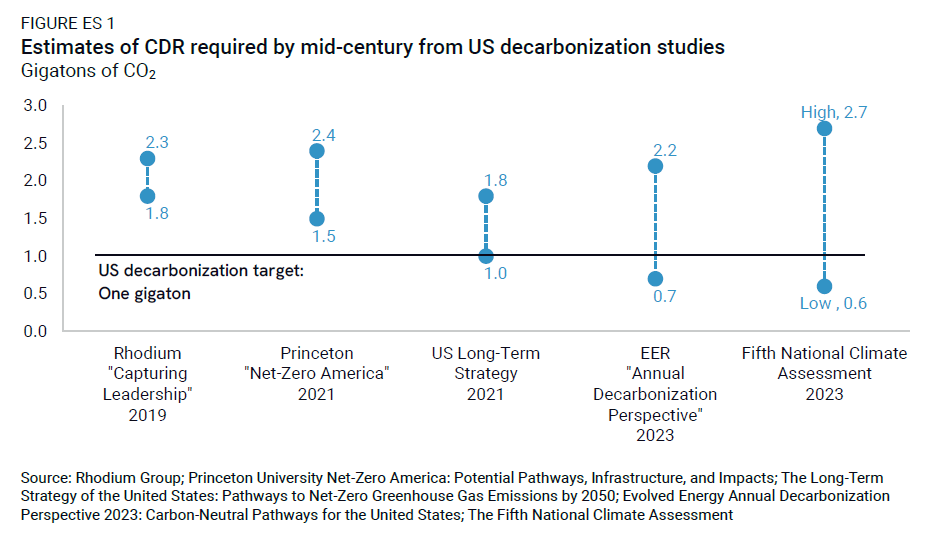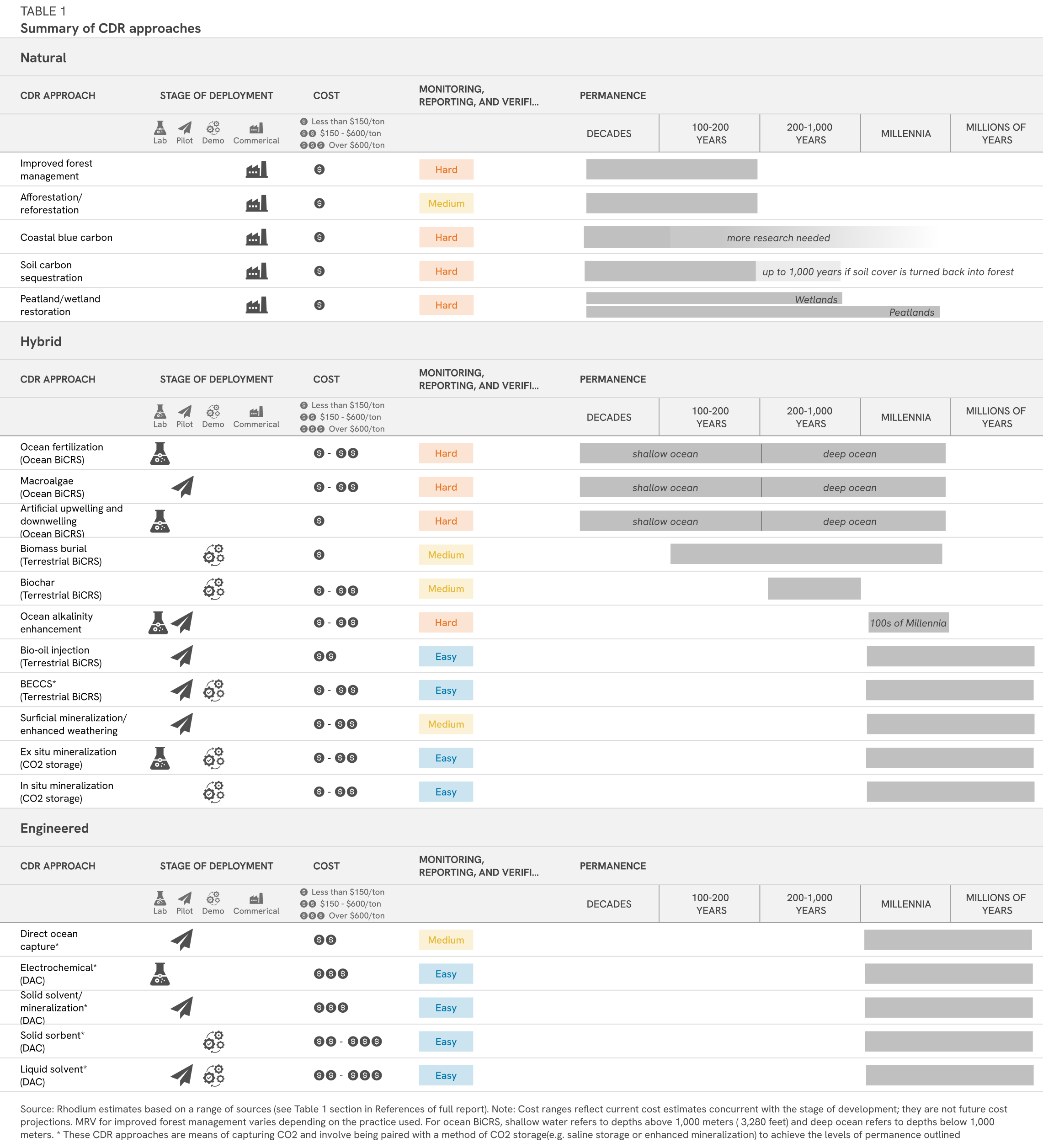As the speed, scale, and complexity of achieving US economy-wide decarbonization are better understood, carbon dioxide removal (CDR) is gaining more attention as an important piece of the puzzle. CDR is a broad set of processes and technologies that result in the net removal of CO2 from the atmosphere. Because of policies implemented over the past few years, the US is now a global leader in policy support for CDR. However, more federal policy support is needed to expand the portfolio of CDR options and ensure a robust CDR market exists to support the goal of mid-century decarbonization. In this report, we survey the current and vast landscape of different CDR approaches in the US, informed by the latest peer-reviewed literature, dozens of expert interviews, and new analysis. We also assess the current state of policy support and additional policy options to help CDR scale to the level required for mid-century decarbonization in the US.
A robust CDR industry is necessary to complement US decarbonization
Based on global climate models, various decarbonization studies, and our own internal modeling estimates, in order for the US to decarbonize by mid-century, at least one gigaton of annual CDR capacity will need to be available by then (Figure ES1). That’s up from low-single-digit megatons of CDR today and equal to the capacity to remove roughly 20% of the carbon dioxide (CO2) emitted in the US in 2023. All of this CDR is above and beyond what natural carbon sinks are expected to contribute in the land use, land-use change, and forestry sector absent additional policy support. Exactly how much CDR is needed in the coming decades is uncertain and depends on the speed of other decarbonization actions, but access to CDR is undoubtedly an option the federal government needs to invest in to achieve mid-century decarbonization.

CDR can play two primary roles in decarbonizing the US economy. First, it can help the US achieve net-zero emissions by offsetting greenhouse gas (GHG) emissions from particularly hard-to-abate sectors, such as aviation and industry. Second, CDR can remove anthropogenic emissions that already exist in the atmosphere, often referred to as legacy emissions, to limit global temperature rise or, over time, potentially reduce global temperatures. Looking past mid-century and assuming the US and the world successfully decarbonize, CDR is the only strategy that can continue to reduce atmospheric concentrations of CO2 in the long run. It’s important to note that CDR is not a comprehensive solution for US decarbonization nor an excuse to continue emitting as usual. Instead, it is a strategy to complement deep emissions cuts across all sectors in an effort to limit global temperature rise as fast as possible.
Supporting a diverse array of CDR approaches
There is a wide variety of ideas and companies for removing carbon dioxide from the atmosphere, and more ideas are continuously being explored. In this report, we provide an overview of the current primary CDR approaches, divided into three categories: natural, hybrid, and engineered solutions. These approaches, summarized in Table 1, vary on intertwined factors including cost, scalability, tech readiness, permanence of carbon storage, and ease of monitoring.
In addition to increasing the magnitude of policy support, the US needs to support a diverse range of CDR approaches. There are risks involved in putting all decarbonization eggs in one technology basket. If the US invests in scaling up CDR, federal policy should be designed to incentivize a set of CDR solutions that maximizes avoided climate damages while minimizing costs to US taxpayers. All approaches have a role to play in a robust CDR portfolio, and policy should be designed to complement the various CDR attributes.
Policy support is needed to establish, expand, and scale the CDR market
In recent years, the US has jump-started investment in federal policies that support CDR. Some of the most important include revamped R&D programs, the regional direct air capture (DAC) hubs program, an expansion of the section 45Q tax credit, and USDA programs funding natural CDR. Combined, these actions make the US a global leader in CDR policy support. However, current policy will support less than 1% of what may be needed for economy-wide decarbonization. The magnitude of policy necessary to support a gigaton-scale CDR industry is on the order of 20 times larger than current policy support today.
Additional federal policy support is necessary to establish a large-scale, long-term revenue market for carbon dioxide removal in the US. Even with optimistic growth assumptions, voluntary markets alone are not enough. We find that policy support is still necessary to provide the majority of the roughly $100 billion in annual revenue needed to support a gigaton-scale CDR market. Policy support is also needed to expand the portfolio of CDR technology options available and scale CDR approaches that are ready to advance to the pilot, demonstration, or early deployment phases. In this report, we break policy support opportunities into three major areas: 1) demand-side policies, 2) research and development (R&D) policies, and 3) demonstration and deployment policies, and we expand on their details and considerations.
Establish large-scale, long-term revenue: demand-side policy
If the US government wants to be on track for a gigaton of CDR by mid-century, it will need to establish a reliable revenue market through demand-side policy, which can provide a long-term (at least 10 years), predictable revenue source to remove and store CO2. We recommend demand-side policies collectively target providing annual revenue support to CDR of a minimum of $20 billion, $50 billion, and $100 billion in 2030, 2040, and 2050 respectively. Supporting multiple policy mechanisms summarized below will provide more political durability and increase the likelihood of achieving these minimum thresholds. These policy options include:
Production tax credits: These policies incentivize CDR on a $/ton of removal basis. This could be in the form of one overall CDR tax credit or multiple tax credits aimed at different approaches.
Procurement programs: These programs can be designed so the government sets a CDR goal that they are willing to fund, and the market bids in to accomplish that goal. Similarly, the federal government could develop something like the advanced market commitments seen in the private sector for CDR.
Regulatory programs: Regulatory programs like economy-wide or sectoral-level emissions standards can create markets that allow CDR as a compliance mechanism. A state-level example is the California Low-Carbon Fuel Standard (LCFS), which includes DAC as a compliance option. Policies like these can be created at the federal level.
Expand the technology options: research and development policy
Many CDR approaches and technologies already exist, but further R&D can help discover novel technological designs and expand the research around CO2 permanence and monitoring, reporting, and verification (MRV). R&D programs should include substantial support for pilot projects and test centers to transition technologies out of the lab into real-world operating conditions. A comprehensive CDR R&D program can be developed, or existing individual programs can be expanded to fund a more diverse set of CDR approaches. If the US government wants to be on track for a gigaton of CDR by mid-century, we recommend a minimum of $6 billion in total R&D policy support over the next 10 years, including funding for pilot projects and test centers.
Scale the industries: demonstration and deployment policy
Demonstration and deployment policies can help CDR scale by supporting companies to transition out of the pilot phase, increase the facility size, overcome operational hurdles, and drive cost learning. These policies support approaches in the demonstration and early-deployment stage by providing or securing a large part of the capital investment required to build CDR facilities. Policy support for each stage ensures the approach will successfully achieve full-scale deployment, assuming long-term revenue is available. If the US government wants to be on track for a gigaton of CDR by mid-century, we recommend a minimum of $18 billion in total demonstration and deployment policy support over the next 10 years. Policy options include:
Demonstration programs: Once companies have piloted operations and are ready to scale their facilities, they still face enormous capital costs to build their initial large-scale operations, including the costs of feasibility studies and basic engineering. Demonstration programs like the current DAC Hubs can be replicated for other CDR approaches.
Loan guarantees: When companies are in the demonstration and early-deployment phases, they still face technological and operational risk that makes securing financing a challenge. The federal government can assist with these financing hurdles by providing loan guarantees.
In Chapter 1 of this report, we look at the role of CDR in economy-wide decarbonization and the scale needed to support mid-century decarbonization. In Chapter 2, we provide an overview of the diversity of CDR approaches available. In Chapter 3, we consider key themes and considerations in the broader conversation around scaling CDR approaches and policy design. Chapter 4 overviews current policy support for CDR and the remaining gap. And in the final chapter, we detail policy support options for establishing, expanding, and scaling the CDR industry.



